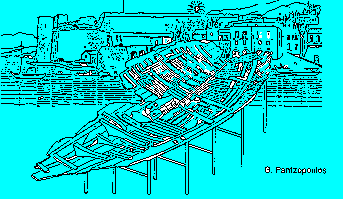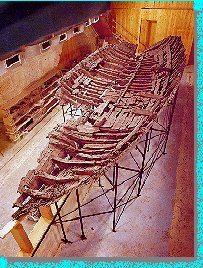

AIR-CONDITIONING SYSTEM FOR PRESERVATION OF CAPTIVE"GREEK SAILING SHIP OF KYRENIA" |
 Here's a story that's generally unknown ... We heard it casually while seeking information about the "Kyrenia Ship" and particularly about its replica that was built by the Hellenic Institute for the Preservation of Nautical Tradition.
Well, after the Turkish Invasion of Cyprus, the original Kyrenia Ship found itself captive at the mercy of the invaders in the castle museum which turned out to be its
"prison". There it could have rotted away if the Cyprus Government and the Cyprus Department of Antiquities in particular had not made provision for the installation of an air-conditioning system in the area where the ship is held captive! - an impressive and, perhaps, unprecedented move ..
Here are the simple unadorned details in the cold language of the Director of the Cyprus Department of Antiquities, Mr V. Karageorgis:
"We had gone far ahead with the procedure of installing a large air-conditioning system in the area that houses the Kyrenia Ship. We had ordered the unit from abroad and expected to receive and place it in the castle museum. Then came the Turkish Invasion, our archaeological treasures were imprisoned, our monuments became inaccessible and, as if this was not enough, they were looted, and stolen items were smuggled abroad. The process of manufacturing the unit had continued and in 1975 it reached Cyprus all packaged up. But what could we do with this equipment that had cost the Republic of Cyprus 9.000 pounds?
(around 305.000 drachmas - which, in 1975, was really a lot of money)
We acted like King Solomon... We had to find the golden mean at any cost in order to solve the problem and
preserve the ship, which was in danger of ... disintegrating any time, as ... wax was used for its preservation. (the scientific term for this preservative is polyethylenoglycole).
We appealed to the UN Peace-keeping Force and persuaded them to under- take installation of the unit in the area of the imprisoned ship. Due to prevailing circumstances, we, ourselves, would never have been able to cross the Green Line and reach Kyrenia Castle".
"How did the Turks react towards this, Mr Karageorgis?" we asked.
"It was a godsend for them. They saw it as a rescue operation to keep the ship in good shape. Between us, they wouldn't have had a clue about what to do if the ship had started "to disintegrate"."
The Director of Cyprus Antiquities concluded his story with two other facts that make this uncommon enterprise of preserving an archaeological find all the more exciting:
The first one was this. "We asked the Turks to return to us the two small air-conditioning units in exchange for the large device we sent them. They categorically refused. Apparently they considered them spoi7s of war, of the invasion they had carried out."
The second interesting fact was this: Every now and then the large unit would break down - either because of bad handling or excessive use. We then had to send out repair groups to fix it! And all this was, of course, carried out with UNFICYP escort as there was no written or other type of communication with the Turkish authorities. We simply heard about the failure of the unit and sent our men to fix it. But this did not last very long.
One day, for reasons that are still unknown to us, The Turks didn't allow our men to enter the occupied areas So, at the time of speaking we do not really know whether our unit is still in operation or if it has broken down and the Turks can't get it fixed. "
But why are we so concerned about the ship of Kyrenia? "'Very simply we can say that it is a priceless archaeological find - considering the fact that it is the oldest trading ship known today'; said Mr Karagiorgis.
"Tachydromos" magazine, issue 31. Athens, 31 July 1986, pp. 72-73. V. KARAGEORGIS'S interview was given to V. KAVVATHAS).
"The decision of the Government of the Republic of Cyprus to send to the pseudostate the air-conditioning units that are required for the preservation of the ship is an act that reminds at least myself of the ammunition that the Greeks sent during the war for Greek Independence to the Turks who were barricaded in the Acropolis, choosing to die rather than see their ancient monuments destroyed in order to provide gunpowder".
Here's a story that's generally unknown ... We heard it casually while seeking information about the "Kyrenia Ship" and particularly about its replica that was built by the Hellenic Institute for the Preservation of Nautical Tradition.
Well, after the Turkish Invasion of Cyprus, the original Kyrenia Ship found itself captive at the mercy of the invaders in the castle museum which turned out to be its
"prison". There it could have rotted away if the Cyprus Government and the Cyprus Department of Antiquities in particular had not made provision for the installation of an air-conditioning system in the area where the ship is held captive! - an impressive and, perhaps, unprecedented move ..
Here are the simple unadorned details in the cold language of the Director of the Cyprus Department of Antiquities, Mr V. Karageorgis:
"We had gone far ahead with the procedure of installing a large air-conditioning system in the area that houses the Kyrenia Ship. We had ordered the unit from abroad and expected to receive and place it in the castle museum. Then came the Turkish Invasion, our archaeological treasures were imprisoned, our monuments became inaccessible and, as if this was not enough, they were looted, and stolen items were smuggled abroad. The process of manufacturing the unit had continued and in 1975 it reached Cyprus all packaged up. But what could we do with this equipment that had cost the Republic of Cyprus 9.000 pounds?
(around 305.000 drachmas - which, in 1975, was really a lot of money)
We acted like King Solomon... We had to find the golden mean at any cost in order to solve the problem and
preserve the ship, which was in danger of ... disintegrating any time, as ... wax was used for its preservation. (the scientific term for this preservative is polyethylenoglycole).
We appealed to the UN Peace-keeping Force and persuaded them to under- take installation of the unit in the area of the imprisoned ship. Due to prevailing circumstances, we, ourselves, would never have been able to cross the Green Line and reach Kyrenia Castle".
"How did the Turks react towards this, Mr Karageorgis?" we asked.
"It was a godsend for them. They saw it as a rescue operation to keep the ship in good shape. Between us, they wouldn't have had a clue about what to do if the ship had started "to disintegrate"."
The Director of Cyprus Antiquities concluded his story with two other facts that make this uncommon enterprise of preserving an archaeological find all the more exciting:
The first one was this. "We asked the Turks to return to us the two small air-conditioning units in exchange for the large device we sent them. They categorically refused. Apparently they considered them spoi7s of war, of the invasion they had carried out."
The second interesting fact was this: Every now and then the large unit would break down - either because of bad handling or excessive use. We then had to send out repair groups to fix it! And all this was, of course, carried out with UNFICYP escort as there was no written or other type of communication with the Turkish authorities. We simply heard about the failure of the unit and sent our men to fix it. But this did not last very long.
One day, for reasons that are still unknown to us, The Turks didn't allow our men to enter the occupied areas So, at the time of speaking we do not really know whether our unit is still in operation or if it has broken down and the Turks can't get it fixed. "
But why are we so concerned about the ship of Kyrenia? "'Very simply we can say that it is a priceless archaeological find - considering the fact that it is the oldest trading ship known today'; said Mr Karagiorgis.
"Tachydromos" magazine, issue 31. Athens, 31 July 1986, pp. 72-73. V. KARAGEORGIS'S interview was given to V. KAVVATHAS).
"The decision of the Government of the Republic of Cyprus to send to the pseudostate the air-conditioning units that are required for the preservation of the ship is an act that reminds at least myself of the ammunition that the Greeks sent during the war for Greek Independence to the Turks who were barricaded in the Acropolis, choosing to die rather than see their ancient monuments destroyed in order to provide gunpowder".
 Go back to the previous page
Go back to the previous page